Physical Address
304 North Cardinal St.
Dorchester Center, MA 02124
Physical Address
304 North Cardinal St.
Dorchester Center, MA 02124
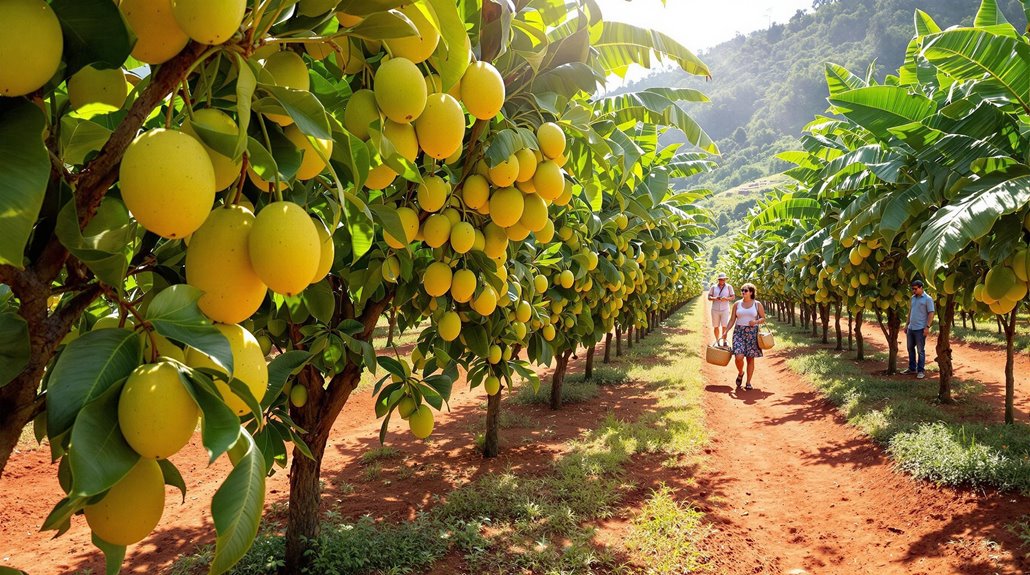
Navigate Colombia's exotic fruit paradise with local guides at Medellín's Plaza Minorista, where unfamiliar flavors await curious taste buds.
You'll discover Colombia's most intriguing fruits without breaking the bank on a guided market tour in Medellín. As you wander through the bustling Plaza Minorista, you'll encounter everything from spiky dragon fruit to creamy custard apples that you won't find back home. While anyone can visit the market solo, joining a knowledgeable guide transforms a simple shopping trip into an insider's journey through Colombia's agricultural heritage. There's much more to uncover about this unique experience.
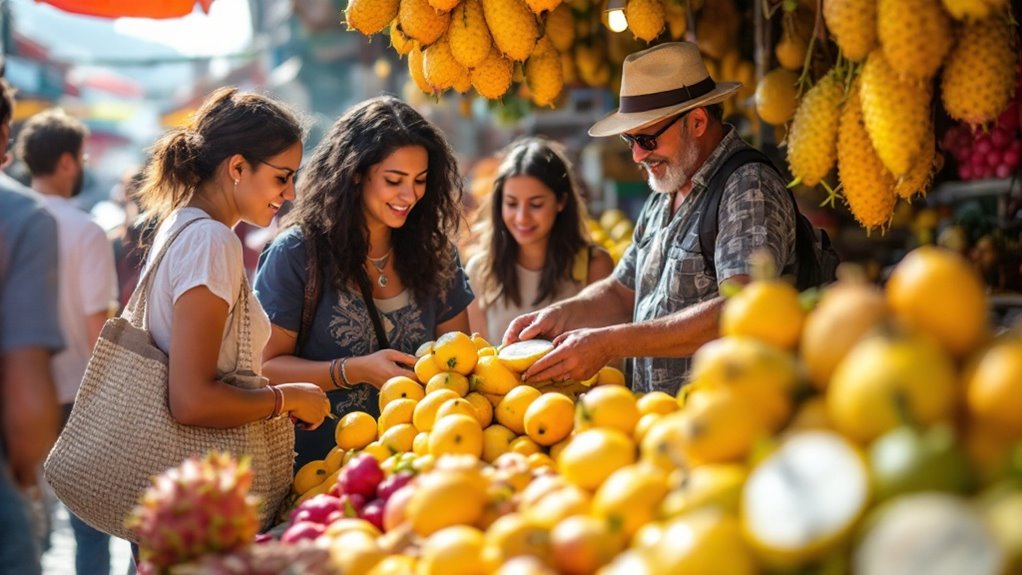
When you step into Medellín's bustling market scene, you'll discover three distinct destinations: the wholesale hub Mayorista, the sprawling Plaza Minorista, and the intimate Placita de Flores. Each market caters to different needs, from bulk purchases to small-business retail.
You'll find over 15 exotic fruits to sample, with vendors enthusiastically offering free tastings of premium seasonal produce. Don't miss the mangosteen, dragon fruit, and guanábana. Some fruits are best enjoyed fresh, while others shine in juice form mixed with honey or milk. The guided tour experience lets you taste approximately 13 different fruits and juices throughout your visit.
Local fruit experts recommend visiting during the morning hours when produce is at its freshest and the market atmosphere is most vibrant.
As you explore, you'll notice the markets' rich cultural heritage through hand-painted stall signs and religious symbols.
Keep an eye out for traditional snacks like arepa de chócolo and indigenous herbal remedies sold alongside fresh produce, reflecting Medellín's deep agricultural roots.
Since all fruit tours depart from Plaza Minorista's main entrance, you'll meet your guide near "Aquí Paró Lucho Restaurante" where they'll be holding a purple umbrella.
The guide will give you verbal directions if needed, as GPS coordinates aren't typically provided. Many visitors attend these market tours on Saturdays and Sundays, coinciding with local shopping patterns.
No need for GPS coordinates – our knowledgeable guides are ready to point you in the right direction.
You can choose from three tour duration options to fit your schedule and budget. The quick 60-90 minute version covers the essentials, while the standard 2-2.5 hour tour offers a more thorough experience.
For fruit enthusiasts, there's a 3-4 hour in-depth exploration. Tours start as early as 5:00 AM, with various time slots throughout the day.
Groups are kept intimate with a maximum of 6-8 participants, ensuring personal attention.
For families or private groups, custom tours can be arranged upon request.
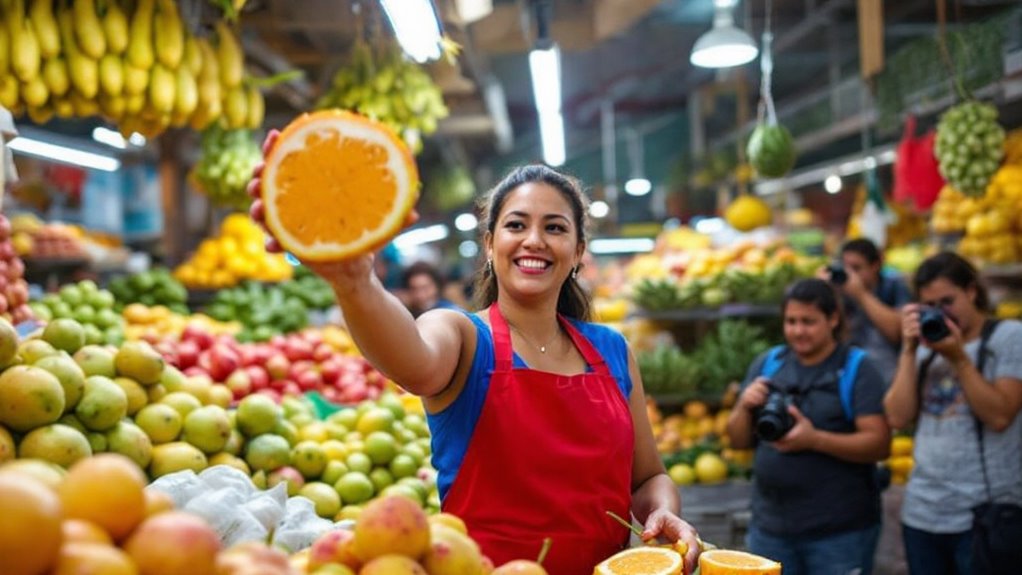
Beyond knowing where to meet and how long your tour will last, mastering market navigation can make or break your fruit-tasting experience at Plaza Minorista.
Keep your belongings secure by wearing a front-facing bag and storing valuables in zipped compartments. With up to 3,000 active vendors filling the heart of Minorista daily, you'll want to stick close to your guide, especially in crowded areas.
Wear comfortable shoes with good traction – market floors can get slippery. Bring small bills (COP 20k notes) and a reusable shopping bag if you're planning to buy fruits.
Visit between 7-11 AM for the freshest selections and most active vendor interactions. When approaching stalls, remember to ask "¿Cuánto cuesta?" for prices and always request permission before taking photos.
Don't rush the experience – vendors often share fascinating family stories about their businesses.
While Colombia is famous for its coffee, the incredible variety of exotic fruits you'll discover at Plaza Minorista might steal the show.
You'll encounter lively dragon fruit with its spotted white flesh and the creamy soursop that tastes like a strawberry-pineapple blend. Don't miss the uchuva, a tiny orange fruit that's become one of Colombia's top exports.
Dragon fruit dazzles with speckled white flesh, while soursop offers a creamy strawberry-pineapple paradise. Colombia's tiny uchuva brightens any fruit basket.
For the adventurous, try borojó, packed with natural energy-boosting properties, or chontaduro, which you'll need to boil first but offers protein levels similar to eggs. As the second most biodiverse country globally, Colombia's unique geography yields an astounding array of fruit varieties.
The sweet-tart gulupa and granadilla make perfect snacks, while the badea and mangosteen deliver unique tropical flavors you won't find back home.
Watch for the star-shaped cross-section of carambolo and caimito – they're as photogenic as they're delicious.
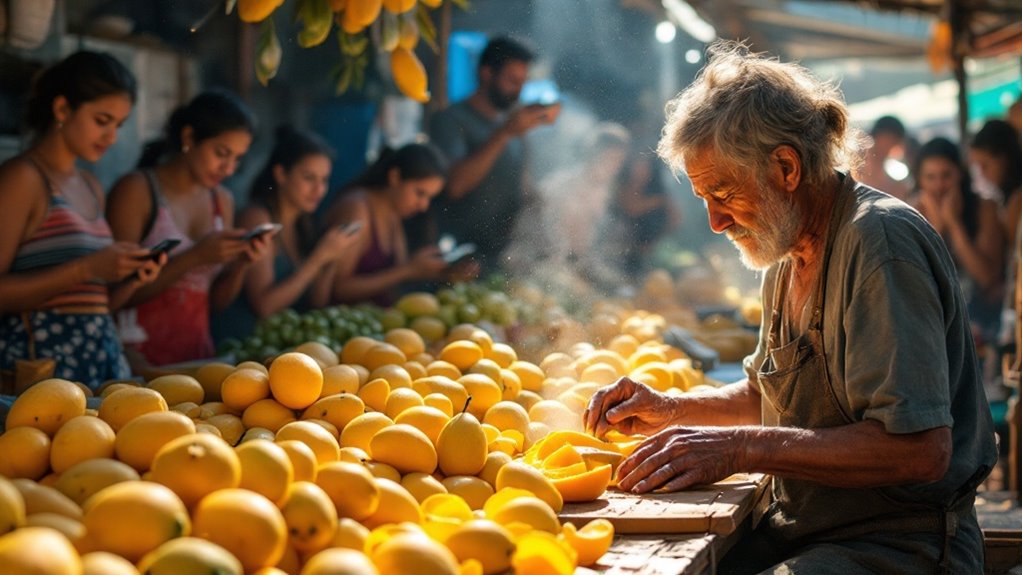
The real treasures of Medellín's markets aren't just the exotic fruits – they're the passionate vendors who've spent decades perfecting their craft.
These experts enthusiastically share their deep knowledge about fruit origins, growing conditions, and traditional preparation methods.
You'll learn how to select the ripest fruits, proper peeling techniques, and ways to blend them into invigorating juices.
The Plaza Minorista market features an incredible selection of exotic fruits with up to 3,000 vendors sharing their knowledge.
Vendors often demonstrate the best ways to eat unfamiliar fruits like lulo and granadilla while explaining their health benefits. They'll even share family recipes and suggest complementary local ingredients.
For the best experience, arrive between 6-8 AM when vendors are most available for conversation.
Bring small bills, and if you're not confident in Spanish, consider joining a guided tour for translation support.
Remember to ask permission before taking photos of stalls or products.
Discovering Medellín's fruit markets opens a window into Colombia's rich cultural heritage, where centuries-old traditions blend with modern-day practices.
You'll observe how deeply fruits are woven into local customs, from the traditional salpicón refreshment to the sacred use of certain fruits in spiritual ceremonies.
At Plaza Minorista, you'll encounter over 2,500 stalls where vendors still use traditional measurement tools like arrobas for bulk sales. The tour includes exploring and tasting over 60 exotic fruits while learning about their significance in Colombian culture. During your visit, you might catch live performances of música carrilera or see traditional dances like bambuco and pasillo.
Don't miss the chance to try tamarind candies in Sopetrán or taste chontaduro with salt or honey from street vendors.
These experiences connect you directly with Antioquia's cultural roots while keeping your spending modest and authentic.
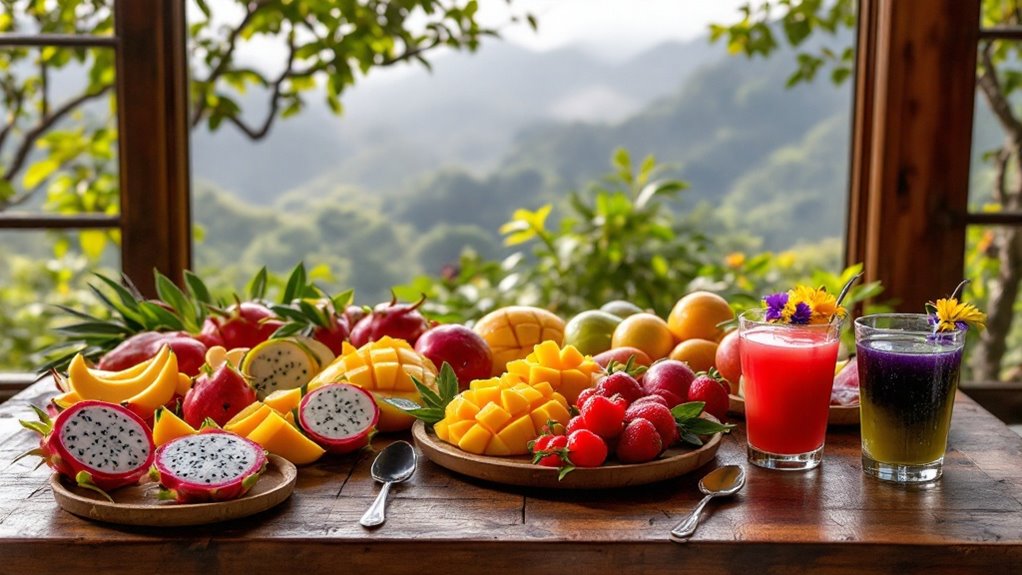
Ready to maximize your fruit-tasting adventure in Medellín? To get the most value from your experience, engage all your senses while sampling Colombia's exotic fruits. You'll want to smell, touch, and observe each fruit before tasting it.
Follow these key steps for the best tasting experience:
Don't forget to jot down your impressions right after tasting – those subtle flavor notes can fade quickly from memory.
Before starting your Medellín fruit tour, you'll need to tackle several practical preparations to guarantee a smooth and enjoyable experience.
Book your spot well in advance, as tours fill quickly, and arrive 15 minutes early at the Plaza Minorista entrance. With no advance payment required for booking, you can reserve risk-free. Don't forget to bring cash for purchases and a reusable bag to carry your fruits.
Reserve ahead for this popular market experience and come early with cash and bags ready for fruit-filled adventures.
Wear comfortable walking shoes and sun protection, as you'll spend nearly three hours exploring multi-level market spaces.
Pack a refillable water bottle and personal mask. If you're using public transit, research routes beforehand, as parking can be limited.
Learn basic Spanish phrases for vendor interactions, and remember to ask permission before taking photos.
Keep valuables secure and follow your guide's instructions to respectfully navigate the market environment.
You will discover that a Medellín fruit tour offers incredible value for your money, packing loads of tastings and cultural insights into just a few hours. Don't forget to bring cash for extra purchases and a small bag for any fruits you want to take home. Wear comfortable shoes, arrive hungry, and you're set for an authentic Colombian market experience that won't break the bank.